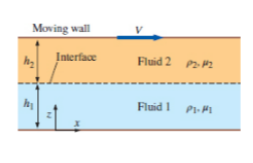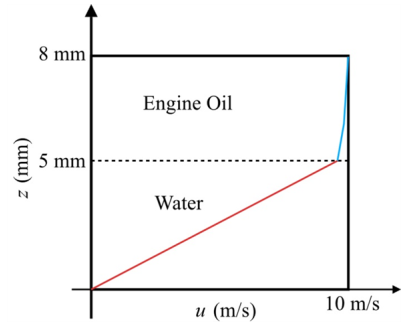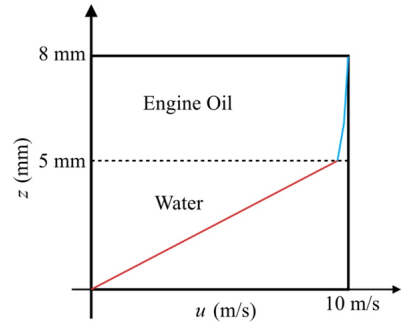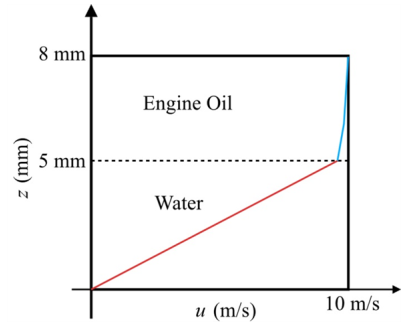
(a)
The six appropriate boundary conditions on both velocity and pressure.
Answer to Problem 136P
The first boundary condition is
The second boundary condition is
The third boundary condition is
The fourth boundary condition is
The fifth boundary condition is
The sixth boundary condition
is
Explanation of Solution
Given information:
The following figure shows that two parallel flat plates.

Figure-( 1)
Assume, at the point of wall and fluid, the velocity of the fluid is equal to zero.
Write the expression for velocity of the fluid 1,
Here, the velocity of fluid 1 is
Assume, the velocity of the fluid 2 at the free surface of the wall is equal to the velocity of the moving plates.
Write the expressions for the velocity of fluid 2.
Here, the velocity of fluid 2 is
Write the expression for velocity at interface.
Write the expression for rate of shear stress.
Here, the kinematic coefficient of fluid is
Write the expression for the shear stress acting on fluid 1.
Here, the kinematic coefficient of fluid 1 is
Write the expression for the shear stress acting on fluid 2.
Here, the kinematic coefficient of fluid 2 is
Write the expression for the rate of shear stress at interface.
Write the expression for pressure at the bottom of the flow,
Here, the pressure is
Write the expression for the pressure at the interface of fluid 1.
Here, the pressure at the fluid 1 is
Write the expression for the pressure at the interface of fluid 2.
Here, the pressure at the fluid 1 is
Assume, at the interface of the fluid the pressure cannot have discontinuity and the surface is ignored.
Write the expression for the pressure at interface of fluid.
Conclusion:
The first boundary condition is
The second boundary condition is
The third boundary condition is
The fourth boundary conditions is
The fifth boundary condition is
The sixth boundary condition
is
(b)
The expressions for the velocity of fluid 1 and 2.
Answer to Problem 136P
The expression for the velocity of fluid 1 is
The expression for the velocity of fluid 2 is
Explanation of Solution
Write the expression for
Here, the velocity of flow for fluid 1 is
Write the expression for
Here, the velocity of flow for fluid 2 is
Calculation:
Integrate Equation (XIII) with respect to
Here, the constant is
Integrate Equation (XIII) with respect to
Here, the constant is
Integrate Equation (XIV) with respect to
Here, the constant is
Integrate Equation (XIV) with respect to
Here, the constant is
Substitute
Substitute
Substitute
Substitute
Substitute
Differentiate Equation (XXI) with respect to
Substitute
Substitute
Substitute
Substitute
Conclusion:
The expression for the velocity of fluid 1 is
The expression for the velocity of fluid 2 is
(c)
The expressions for pressure of fluid 1 and 2.
Answer to Problem 136P
The expression for the pressure of fluid 1 is
The expression for the pressure of fluid 2 is
Explanation of Solution
Write the expression for
Here, the density of the fluid 1 is
Write the expression for
Here, the density of the fluid 2 is
Calculation:
Integrate Equation (XXV) with respect to
Here, the constant is
Substitute
Substitute
Integrate Equation (XXVI) with respect to
Here, the constant is
Substitute
Substitute
Substitute
Conclusion:
The expression for the pressure of fluid 1 is
The expression for the pressure of fluid 2 is
(d)
The plot
Answer to Problem 136P
The following Figure-(2) represents the velocities of fluid 1 and 2.

Explanation of Solution
Given information:
The fluid 1 be water and the fluid 2 be unused engine oil, at
The following figure shows that two parallel flat plates.
Write the expression for the velocity of fluid 1.
Here, the distance is
Write the expression for the velocity of fluid 2.
Calculation:
Refer the Table-A-3E, "Properties of saturated water", to obtain the value of dynamic viscosity of water is
Refer the Table-A-7E, "Properties of the atmosphere at high attitude", to obtain the value of dynamic viscosity of unused engine oil is
Substitute
Substitute
The following graph represents the velocities of fluid 1 and 2.

Figure-(2)
In the fluid 1 the linear curve is increasing with respect to the velocity of flow and height of fluid 1. In the fluid 2 the curve is increasing with respect to the velocity of flow and height of fluid 2.
Conclusion:
The following Figure-(2) represents the velocities of fluid 1 and 2.

Want to see more full solutions like this?
Chapter 7 Solutions
Fluid Mechanics: Fundamentals and Applications
- Please do step by step and fill the table Here is the link of some lecture notes https://dosya.co/pelv7t5eubmo/dispersion.pdf.html https://dosya.co/g2q6mvjhf2qm/forced_hormonic_motion.pdf.html https://dosya.co/jeez83u7cwdt/standing_waves.pdf.html https://dosya.co/lldewupx9d2b/Travelling_Waves.pdf.htmlarrow_forwardThe 300-meter radiotelescope in Arecibo, Puerto Rico(Fig. 25–33), is the world’s largest radiotelescope, butmany other radiotelescopes are also very large. Why areradiotelescopes so big? Why not make optical telescopesthat are equally large? (The largest optical telescopes havediameters of about 10 meters.)arrow_forwardMeasuring in Boundary-layers flows on a flat plate for x= 0.265 and x= 0.115m Lab conditions are: Patm = 750 mm Hg T atm = 19 degrees C Manometer angle Beta = 60 degrees Could you please help me process this dataarrow_forward
- the black sqaure is delta (change) in pressure Assume that p is a function of average velocity V, pipe length L and diameter D, the pipe roughness e (mean height of roughness of the pipe wall, e.g. in microns), and the fluid density . 1.How many nondimensional parameters are needed to define the nondimensional pressure-drop vs. flow relationship in the pipe? 2. Using (D, , and V) as repeating parameters, derive the nondimensional pressure drop and other required parameters to relate p, V, L, D, e , and .arrow_forwardVortices are usually shed from the rear of a cylinder, which are placed in a uniform flow at low speeds. The vortices alternatively leave the top and the bottom of the cylinder, as shown in figure, causing an alternating force normal because of generating a dimensionless relationship for Kármán vortex shedding frequency fk (1/s) as a function of free-stream speed V(m/s), fluid density r (kg/m3), fluid viscosity µ (kg/m.s), sound velocity c (m/s), surface roughness ɛ (m) and cylinder diameter D(m). Solve the problem by making the necessary assumptions and drawing the schematic figure. I-Determine the nondimensional p parameters using repeating variables, involving f, ɛ, c and µ as nonrepeating variables ii-the dynamics of Bhosphorus bridge is investigated in a wind tunnel for the vortex generation behind the wires. A 1/56,2 scaled down model of the hanging wires is used in the laboratory. If vortex shedding frequency of of Bhosphorus bridge 562 Hz is measured in the laboratory at…arrow_forwardSelect a common dimensionless parameter in fluid mechanics from the following: (a) angular velocity; (b) Kinematic viscosity; (c) specific volume; (d) specific weight; ( e) none of these answersarrow_forward
- The Stokes number, St, used in particle dynamics studies,is a dimensionless combination of five variables: accelerationof gravity g , viscosity μ , density ρ , particle velocity U ,and particle diameter D . ( a ) If St is proportional to μand inversely proportional to g , find its form . ( b ) Showthat St is actually the quotient of two more traditionaldimensionless groups.arrow_forwardchoose whether the statement is true or false and discuss your answer briefly. Kinematic similarity is a necessary and sufficient condition for dynamic similarity.arrow_forwardAn airplane flies at constant velocity V-›airplane. Discuss the velocity boundary conditions on the air adjacent to the surface of the airplane from two frames of reference: (a) standing on the ground, and (b) moving with the airplane. Likewise, what are the far-field velocity boundary conditions of the air (far away from the airplane) in both frames of reference?arrow_forward
- A ship is towing a sonar array which approximates a submerged cylinder 2.5 ft in diameter and 30 ft long with its axis normal to the direction of tow. For seawater at 20°C, take ρ ≈ 1.99 slug/ft3 and μ ≈ 2.23E−5 slug/ft·s. If the tow speed is 12 kn (1 kn = 1.69 ft/s), estimate the horsepower required to tow this cylinder. Take CD = 0.31. What will be the frequency of vortices shed from the cylinder? Take fD/U ≈ 0.24.arrow_forwardShip whose full length is 100 m is to travel at 10 m/sec. For dynamical similarity, with what velocity should a 1:25 model of the ship be towed?arrow_forwardA new implantable drug delivery device is being developed in your lab. The device prototype is a very thin strip (0.1mm × 1mm × 15mm) of polymer coated on both sides with 22 milligrams of solid drug particles. To test the drug delivery profile, you "implant the device by suspending it in a homogenous model fluid that has following properties: viscosity = 0.0018 Pa.s, density = 1.32 g cm^-3, temperature = 37°C. The diffusivity of the drug is estimated to be 2.113×10^-6 cm^2/S. 1. Determine how far the drug would penetrate into the fluid in 2.2 hours.arrow_forward
 Elements Of ElectromagneticsMechanical EngineeringISBN:9780190698614Author:Sadiku, Matthew N. O.Publisher:Oxford University Press
Elements Of ElectromagneticsMechanical EngineeringISBN:9780190698614Author:Sadiku, Matthew N. O.Publisher:Oxford University Press Mechanics of Materials (10th Edition)Mechanical EngineeringISBN:9780134319650Author:Russell C. HibbelerPublisher:PEARSON
Mechanics of Materials (10th Edition)Mechanical EngineeringISBN:9780134319650Author:Russell C. HibbelerPublisher:PEARSON Thermodynamics: An Engineering ApproachMechanical EngineeringISBN:9781259822674Author:Yunus A. Cengel Dr., Michael A. BolesPublisher:McGraw-Hill Education
Thermodynamics: An Engineering ApproachMechanical EngineeringISBN:9781259822674Author:Yunus A. Cengel Dr., Michael A. BolesPublisher:McGraw-Hill Education Control Systems EngineeringMechanical EngineeringISBN:9781118170519Author:Norman S. NisePublisher:WILEY
Control Systems EngineeringMechanical EngineeringISBN:9781118170519Author:Norman S. NisePublisher:WILEY Mechanics of Materials (MindTap Course List)Mechanical EngineeringISBN:9781337093347Author:Barry J. Goodno, James M. GerePublisher:Cengage Learning
Mechanics of Materials (MindTap Course List)Mechanical EngineeringISBN:9781337093347Author:Barry J. Goodno, James M. GerePublisher:Cengage Learning Engineering Mechanics: StaticsMechanical EngineeringISBN:9781118807330Author:James L. Meriam, L. G. Kraige, J. N. BoltonPublisher:WILEY
Engineering Mechanics: StaticsMechanical EngineeringISBN:9781118807330Author:James L. Meriam, L. G. Kraige, J. N. BoltonPublisher:WILEY





